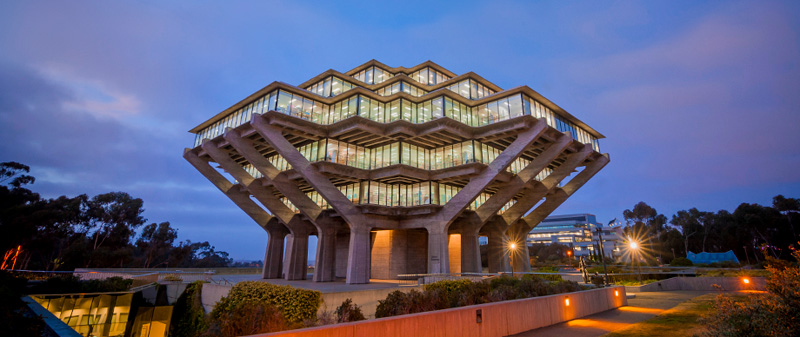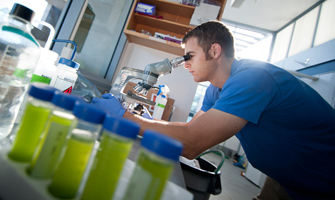UC San Diego Highlighted in Governor’s State of the State Address
Campus touted as one of the world’s 20 leading academic bioscience institutions
By:
- Judy Piercey
Published Date
By:
- Judy Piercey
Share This:
Article Content

Geisel Library is an iconic structure at UC San Diego. Photos by Erik Jepsen/UC San Diego Publications
As Governor Edmund G. Brown Jr. delivered his annual State of the State address to the Legislature yesterday, he highlighted the University of California, San Diego as a leader in developing medical and scientific advances.
In prepared remarks, Gov. Brown noted, “Four out of the world’s 20 leading academic bioscience institutions are located here in California: UCSF and Berkeley, UCLA, Stanford and UC San Diego. Just as California has led the way with stem cell research, so too can we pioneer the new field of precision medicine which uses genomics, medical devices, computer sciences and other fields to treat individual patients, instead of broad populations.”

Scientists transform algae into transportation fuels.
For more than a decade, UC San Diego has been listed among the nation’s top 10 public universities by the U.S. News & World Report Best Colleges Guidebook. The campus was also named 15th best research university in the world by the Centre for Science and Technology Studies of Leiden University in its 2013 list that measured scientific impact of universities worldwide.
“At UC San Diego, our culture of collaboration sparks discoveries that advance society and drive economic impact,” said Chancellor Pradeep K. Khosla. “We are pleased to be recognized by Gov. Brown for our innovation and excellence.”
An outstanding faculty is the hallmark of any great university—and UC San Diego students learn form the best, including Nobel laureates, MacArthur fellows and National Academy members.
Equally exciting is the campus’s cadre of young investigators, poised to impact the state, and the world:

Eric Allen, associate professor of marine biology and molecular biology at Scripps Institution of Oceanography and Division of Biological Sciences, directly confronts unknowns associated with the largest reservoir of genetic diversity on our planet—the microbial world.

Assistant professor of chemistry Rommie Amaro is working on computer models of proteins that will lead to the development of new drugs to treat infectious viruses and bacteria. She’s also mentoring the next generation of scientists.

Jacobs School of Engineering assistant professor Karen Christman is developing biomaterials for tissue engineering and regenerative medicine applications with a particular focus on cardiovascular disease.

Associate professor in bioengineering Todd P. Coleman focuses his research on wireless tattoo technology to transmit vital medical data, bringing yesterday’s science fiction into today’s reality.

Suckjoon Jun, assistant professor of physics and biology, is part of a group of dynamic young researchers fluent in both physics and biology. His research could result in a better understanding of the runaway cell division that leads to cancer.

An assistant professor in the departments of pediatrics and cellular and molecular medicine, Alysson Muotri uses induced pluripotent stem cells from patients with Rett syndrome to create functional neurons that provide the first human cellular model of autism spectrum disorder.

Liangfang Zhang, associate professor in the department of nanoengineering, was recently named to the Technology Review’s 35 under 35 list for his nanosponges that may be used to create vaccines against deadly bacterial infections such as MRSA, a contagious staph bacteria.
As California faces challenges as diverse as climate change, dependency on fossil fuels and disease treatments and cures, the innovators at UC San Diego will lead the charge in finding viable solutions.
Share This:
Stay in the Know
Keep up with all the latest from UC San Diego. Subscribe to the newsletter today.



